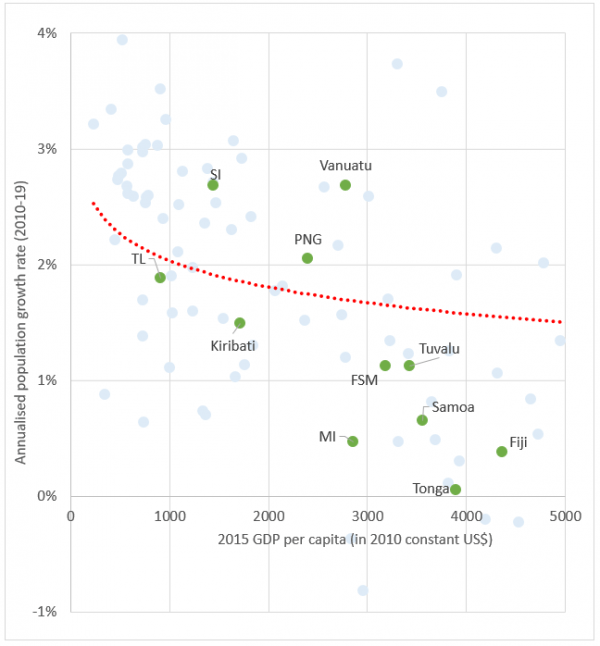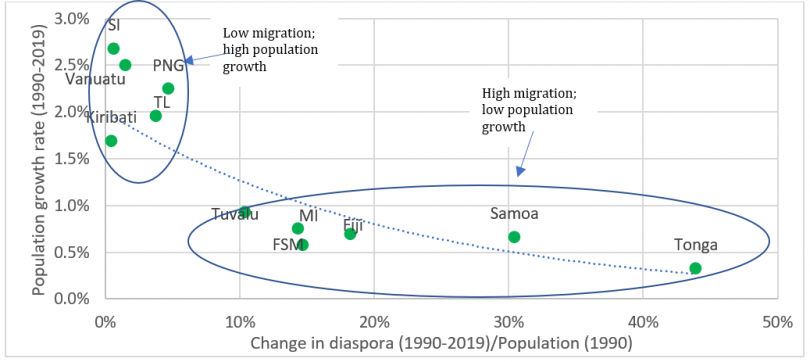Remittances are normally seen as the main benefit of migration that accrues to the sending country, but what about the impact on population? Our previous blog looked at the growth of remittances to Fiji, Samoa, and Tonga, the three “remittance giants” of the Pacific. Despite rapid growth in remittances, the growth of the Fijian, Samoan and Tongan diasporas is not particularly fast. For the last 20 years, these diasporas have grown at around the average of the diaspora for all developing countries (2.6%) in the cases of Fiji (2.8%) and Tonga (2.6%), and below that average for Samoa (1.5%).
However, the distinctive feature of these diasporas is that they are so large relative to their domestic population: 25% in the case of Fiji, 60% for Samoa, and 70% for Tonga. Average growth in these countries’ diasporas therefore converts into high levels of migration and has a profound impact on domestic population growth.
You can see from the graph below that Samoa, Fiji and Tonga have very low population growth rates given their income per capita. Out of 25 countries with GDP per capita (in 2015) in the range from $3,000 to $5,000, Tonga has the third lowest population growth rate, Fiji the sixth lowest, and Samoa the tenth.
Fiji, Samoa and Tonga all lie well under the trend line for developing countries, as do other countries with relatively high migration: Tuvalu, Marshall Islands and FSM. Other Pacific countries with fewer migration opportunities – Kiribati, Timor-Leste, Nauru, PNG, Solomon Islands, Vanuatu – lie around, or in some cases well above, the trend line.
Population growth and income per capita
The next graph looks at the relationship between rates of migration and population growth for the Pacific more explicitly. It shows that the developing countries of the Pacific island region can be divided into two groups: high migration and low population growth, and low migration and high population growth. (We exclude Palau from this analysis since it is a high-income country. Data from other countries is unavailable or unreliable).
The Pacific countries with higher migration (whose diaspora has grown by at least 10% relative to the baseline population of 1990) all have low population growth (1% per annum or less); those with lower migration (growth of 5% or less in the diaspora relative to the 1990 population) have higher population growth (at least 1.5% per annum and normally 2% or more).
Why are there these two groupings? Fertility rates even in some of the high-migration countries are are still quite high (with the exception of Fiji), and, unlike their population growth, not that different from what you’d expect given their income per capita – as the next graph shows.
Fertility rate and income per capita

That leaves the simple fact that with more migration there are fewer people left behind in country. The important difference this makes can be seen by constructing no-migration scenarios, in which population is purely a product of fertility and mortality rates. We can also compare pairs of countries with virtually identical populations in 1990: Timor-Leste and Fiji; and Vanuatu and Samoa. (No similarly-sized, low-migration country could be found as a match for Tonga.)
The results are striking. Without migration, Fiji’s 2019 population would not be 890,000 but 1.2 million. Samoa’s 2019 population would not be 197,000 but 354,000, and Tonga’s not 104,000 but 199,000. In other words, Fiji would be 140% as big as it is now, Samoa 180%, and Tonga 190%.
Comparing over time, Fiji without migration would not be 22% bigger in 2019 compared to 1990, but 70% bigger; Samoa not 22% but 118% bigger, and Tonga not 10% but 109% bigger.
Turning to the third-party comparisons, you can see if you look at the graphs (here) that Timor-Leste looks remarkably like Fiji without migration, and Vanuatu is similar to Samoa without migration.
All Pacific countries struggle with the challenge of job creation. Think how much harder the challenge is for Vanuatu than Samoa, or Timor-Leste than Fiji. It would be naïve to think that, in the constrained contexts of the Pacific, more labour supply and a bigger population would lead to more employment. Rather, in economies with surplus labour, the result would more likely be higher underemployment.
The benefits of migration to the Pacific are not only remittances but also greatly reduced pressure on population and therefore, in a chronically constrained development environment, reduced underemployment. Underemployment is a frequently-remarked on problem in all three countries of Samoa, Tonga and Fiji. These countries would all have much larger populations if there was no migration, and much higher rates of underemployment and therefore poverty.
There is nothing new in this view of migration as a safety valve in the Pacific, which in fact goes back to the 1960s (see Richard Bedford’s excellent survey). Nevertheless, even today, suspicion surrounds migration as a Pacific development strategy. Steve Pollard and David Abbott recently advised Pacific countries to focus on “job creation to replace migration and remittances.” What this analysis suggests is that countries need to focus on both. Even with migration, Pacific economies struggle to create work for those who stay behind. Without migration, it would be even harder.
What this analysis also points to is the urgency of increasing migration opportunities for the low-migration, high-population-growth countries of Kiribati, PNG, Solomon Islands, Timor-Leste and Vanuatu.
Note: Population projections for Fiji, Samoa, and Tonga were calculated using the cohort component method with zero migration. Data source for base populations in 1990, and fertility and mortality rates from 1990-2019: UN World Population Prospects 2019. We use ‘migration’ and ‘out-migration’ interchangeably.




Great article. I am wondering if there have also been notable shifts in the local labour force, particularly for Fiji as we see more expats from other developing countries (e.g Indonesia and Bangladesh) filling roles as skilled and unskilled workers.
As was noted in the UN’s 2014 Report on the State of Human Development in the Pacific: A Report on Vulnerability and Exclusion in a Time of Rapid Change, emigration, particularly to New Zealand, had had a major impact on the population of Samoa. Many young Samoans leave for education and work, or to simply join their families. Others are selected under the Samoan Quota Scheme, which provides for up to 1,100 Samoans to be granted residence in New Zealand each year. The impact of Samoan migration on the population can be seen in an analysis of the 1976 and 2011 census data contained in that report (Box 3.1). This suggested that emigration had amounted to around 50 percent of each 1976 age cohort by the time members had reached their late 30s. For example, people born between 1972 and 1976 would have been aged between 35 and 39 at the 2011 census. In 1976, there were 24,646 children aged between 0 and 4 years living in Samoa. Taking account of the estimated number of natural deaths expected from birth to that age, it was estimated that there should have been a population of about 23,300 aged between 35 and 39 at the 2011 census. In fact, there were only 10,877 persons recorded in the 35-39 year cohort in that census, this suggests that around half of the people in the original 0-4 year age cohort in 1976 had migrated by the age of 35-39 years. Proportionate migration estimates can also be seen from subsequent cohorts in the 1981 and 1986 census suggesting that this is a stable pattern of migration. Sources: 1976 & 2011 Census of Population, Samoa Bureau of Statistics.